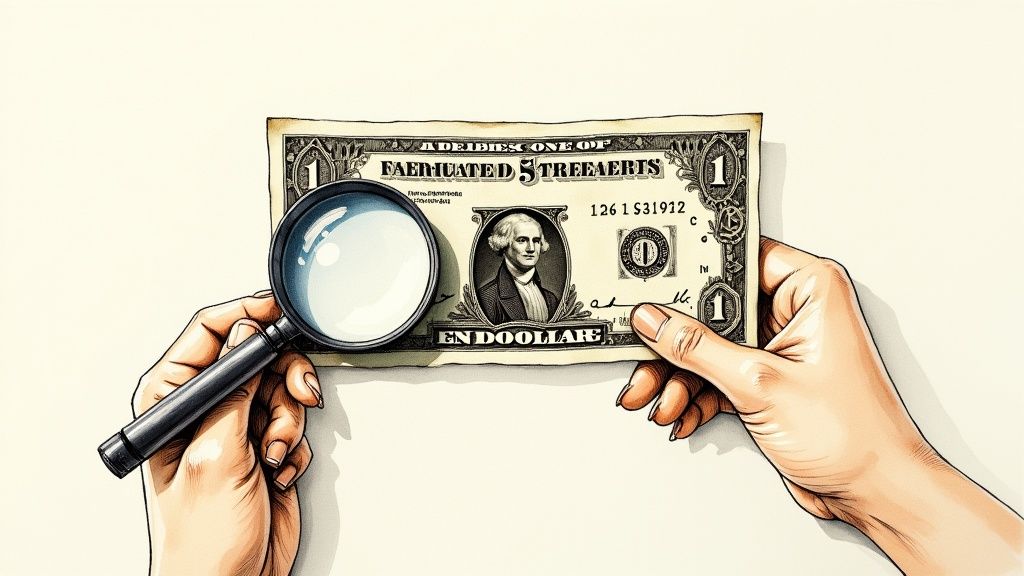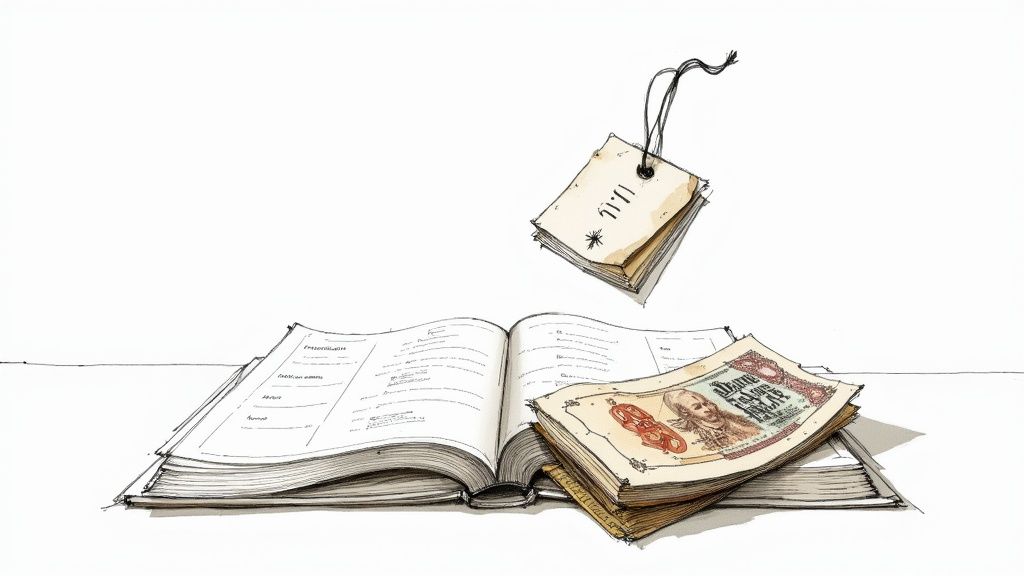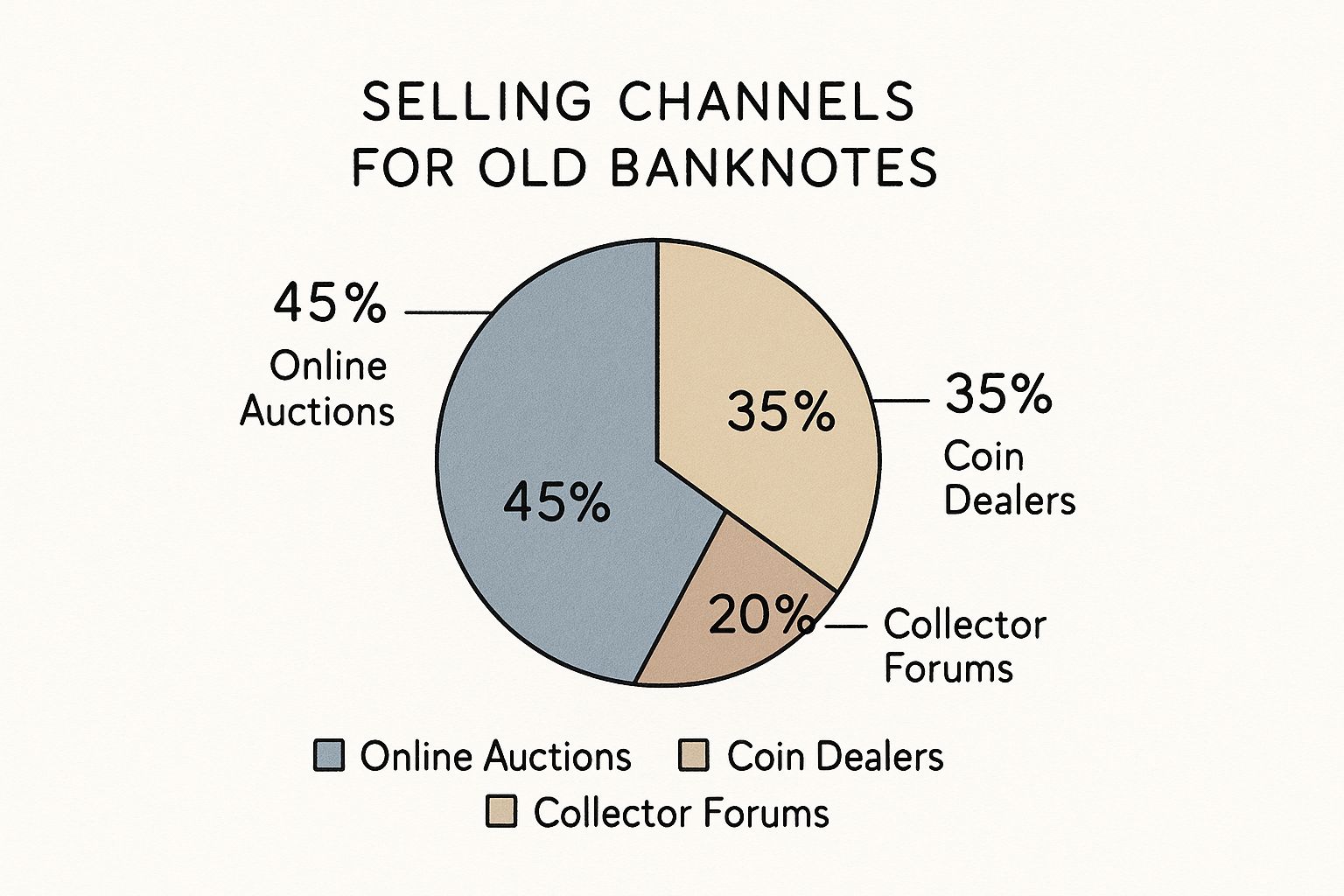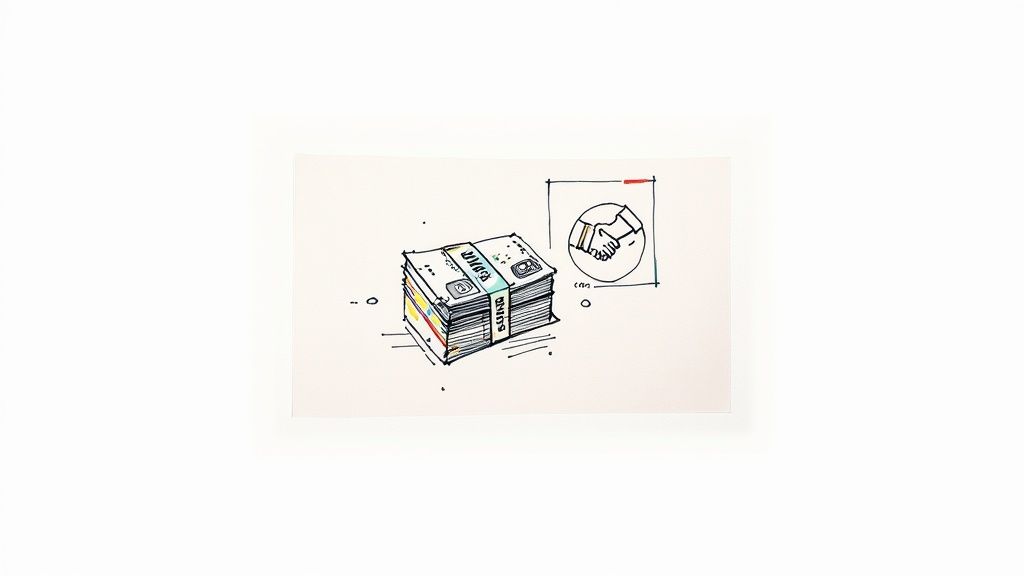Before you even think about where to sell your old banknotes, you need to get a handle on what they're actually worth. An old bit of paper money could be worth its face value, or it might be a hidden gem worth thousands. It all comes down to its condition, how rare it is, and any unique quirks it might have.
How to Find the True Value of Your Old Banknotes

Figuring out the value of your currency isn't just about how old it is; several key factors come together to determine its market price. The journey from a forgotten note in a drawer to a prized collectible starts with a careful look.
Condition Is Everything
The physical state of a banknote, what collectors call its grade, is the single most important factor driving its price. A crisp, clean note that looks like it just came off the printing press will always fetch a much higher price than one that’s heavily folded, stained, or torn. Collectors use a very specific grading scale to classify a note's condition.
The Sheldon grading scale, for instance, runs from Poor (P-1) all the way up to a perfect Gem Uncirculated (70). The difference in value between these grades can be absolutely massive. A common note in average condition might just be a curiosity, but find that same note in uncirculated condition, and you could be looking at a significant find.
Paper Money Guaranty (PMG), one of the top third-party grading services, provides a clear scale. It shows how notes are categorised from pristine "Uncirculated" down to "Poor," with specific criteria for things like folds, soiling, and tears. Getting your head around these terms is the first real step in assessing what you've got.
Rarity and Unique Features
Once you've assessed the condition, rarity is the next big value driver. Some notes were printed in very small numbers, or very few have managed to survive over the years. And rarity isn't always about age; it's about scarcity.
Keep an eye out for other unique details that can make a note far more appealing to a collector:
- Star Notes: These are replacement notes, printed to substitute for faulty ones during production. They're often marked with a star symbol next to the serial number and are much scarcer than regular notes.
- Error Notes: Mistakes happen, even at the mint! Things like misprints, cutting errors, or mismatched serial numbers create "error notes," which are highly sought after by collectors.
- Low or Fancy Serial Numbers: A note with a very low serial number (like 00000100) or an interesting pattern (such as 'radars' where the number reads the same forwards and backwards) can be extremely valuable.
Key Takeaway: A banknote’s story—its history, any printing errors, or a unique serial number—often adds more to its value than its age alone. A tiny detail can turn an ordinary note into something truly special.
For a deeper dive into all these valuation factors, you can learn more about how to value old paper money in our detailed guide.
Preparing Your Banknotes to Attract Serious Buyers

How you present your old banknotes can make a huge difference to their final sale price. A little bit of thoughtful preparation goes a long way, signalling to serious buyers that you've got a quality item worth their attention.
The golden rule is a simple one: do not clean, repair, or alter your banknotes. Seriously. Trying to remove a bit of dirt or fixing a tear with tape will almost certainly destroy its collectible value. Even a minor, well-intentioned "touch-up" can be spotted a mile off by an expert and will drastically lower your potential return. Just leave them as they are, in their original, untouched state.
Instead, your focus should be on safe handling and proper storage. Always handle notes with clean, dry hands—or even better, with cotton gloves—to avoid transferring natural oils and dirt. Store them individually in archival-quality, acid-free plastic sleeves. These are inexpensive and offer crucial protection from moisture, creases, and other environmental damage while you're figuring out where to sell.
Photographing for Success
Your photos are probably your most powerful sales tool. You need to create clear, honest, and appealing images that show the note’s condition accurately. A blurry or poorly lit photo is a major red flag for any potential buyer and they'll likely just scroll on by.
Follow these simple tips to get much better images:
- Use Natural Light: Find a spot near a window with plenty of indirect sunlight. This helps avoid harsh shadows and glare, letting the note's true colours show.
- Show Everything: Take high-resolution photos of both the front and the back. Get close-ups of key features like serial numbers, signatures, and, importantly, any visible flaws. Transparency builds trust.
- Use a Plain Background: Place the note on a solid, neutral-coloured background like black or white. This makes the details really pop and looks far more professional.
By presenting your notes properly, you show respect for the item and its history. This professionalism attracts genuine collectors who are willing to pay a fair price for well-preserved pieces of currency.
Choosing the Best Place to Sell Your Banknote Collection
Once you've got a handle on your banknotes' value and have them ready for sale, you've reached a critical fork in the road: where do you actually sell them? This decision is bigger than you might think. The channel you choose can make a huge difference to your final payout, how quickly you get your money, and how much legwork you have to do yourself.
The good news is that you’re selling into a surprisingly strong market. Numismatics—the world of coin and banknote collecting—is buzzing with activity. Recent research shows the global coin collection market is on an impressive growth trajectory, predicted to jump from USD 10.74 billion in 2024 to an enormous USD 23.87 billion by 2032. This tells us there are plenty of keen buyers out there, which is exactly what you want to hear as a seller. If you're curious, you can read the full research on this market growth.
So, where are all these sales happening?

As you can see, online auctions are a massive part of the market, but don't overlook traditional dealers and collector communities. They still account for a huge slice of the pie.
Exploring Your Sales Channel Options
Let's break down what each of these options really means for you.
Online marketplaces like eBay are fantastic for reaching a global audience of potential buyers. The downside? You are in the driver's seat for the entire journey. That means taking high-quality photos, writing compelling descriptions, patiently answering questions, and then carefully packing and shipping the items once they sell. It's a lot of work.
On the flip side, walking into a local coin dealer's shop is the essence of simplicity. You can get an on-the-spot offer and potentially leave with cash in your pocket. The trade-off is that a dealer needs to turn a profit, so their offer will naturally be below the note's full retail value. You're essentially paying for speed and convenience. If you're dealing with coins as well, our guide on where you can sell your coin collection covers very similar ground.
Expert Tip: If you're sitting on a truly rare or high-value collection, your best bet is often a specialist numismatic auction house. These pros have direct lines to serious, high-spending collectors and will market your notes professionally. The catch? Their commission fees are higher, reflecting that expert service.
Comparing Where to Sell Old Banknotes
To make things a bit clearer, I've put together a table that lays out the pros and cons of the main sales channels. Think about what your priority is—are you chasing the highest possible price, or do you just want a quick, hassle-free sale?
| Sales Channel | Potential Price | Speed of Sale | Effort Level | Typical Fees |
|---|---|---|---|---|
| Online Auctions (eBay) | High | Medium | High | 10-15% |
| Specialised Auction House | Very High | Slow | Low | 15-25% |
| Direct to a Dealer | Lower | Very Fast | Very Low | None (lower offer) |
| Collector Forums | High | Slow | Medium | 0-5% |
Looking at the options side-by-side really helps clarify the trade-offs. A dealer offers speed but a lower price, while a specialist auction house can achieve top-tier prices but requires patience and will take a significant commission. The right choice truly depends on your notes and your personal goals.
Mastering Online Auctions and Direct Sales

When you decide to sell your old banknotes online, the quality of your listing is absolutely everything. Platforms like eBay throw you into a global arena, which is fantastic, but it also means you’re fighting for every eyeball. Your success really boils down to creating a listing that screams trustworthiness and gives a serious collector all the details they need to bid with confidence.
Your title is your first, and arguably most important, hook. You have to be specific and cram it with the keywords collectors are actually searching for. A vague "Old Ten Shilling Note" will get lost in the noise.
Instead, try something like: "UK Ten Shilling Note 1955 O'Brien B372 - Good Fine (GF) Condition." See the difference? That title includes the country, denomination, date, signatory (a critical detail for collectors), catalogue number, and the grade. It’s a complete package.
Crafting the Perfect Listing
Once you’ve got their attention, your description is where you seal the deal. Repeat the key details from the title but expand on them. This is your chance to mention any interesting history, and be brutally honest about flaws like pinholes, tears, or heavy folds. Transparency isn’t just a nice-to-have; it's non-negotiable. An honest description builds the trust needed to get those higher bids.
When it comes to pricing, you’ve got two main routes to go down:
- Auction Style: This is my personal favourite for most notes. Starting the bidding low, say at £0.99, is a brilliant way to attract a flurry of early interest and watchers. This builds momentum and often kicks off a bidding war that pushes the price up to its natural market value.
- Buy It Now: If you have a very firm idea of a note's value and you're prepared to wait for the right buyer to come along, a fixed 'Buy It Now' price is a solid option. I find this works best for scarcer, high-demand items where the market price is well-established.
A classic rookie error is setting a high starting bid for an auction. It’s counter-intuitive, but it often deters the very bidders you want to attract. A low start almost always generates more activity and, more often than not, a higher final price.
Approaching Dealers for a Direct Sale
If the thought of online auctions feels like too much hard work, a direct sale to a reputable dealer offers a much faster path to cash. But don't just walk in unprepared. When you approach a dealer, have your research handy, including any valuation estimates you’ve already gathered.
Present your notes clearly and be ready to negotiate respectfully. It's crucial to understand that a dealer has overheads and needs to make a profit, so their offer will naturally be below the full retail value. You're essentially paying for their expertise and the convenience of an instant, hassle-free sale.
For larger or particularly valuable collections, a dealer might suggest a consignment sale. This is where they agree to sell the notes on your behalf for a commission. If you go this route, always make sure you get a clear, written agreement that outlines all the fees and terms before you hand anything over.
Finalising the Sale and Shipping with Confidence
You’ve found a buyer and agreed on a price. Great! But don’t pop the cork just yet. Getting these final steps right is what separates a good sale from a great one, cementing your reputation and ensuring you get paid without any drama.
First things first: secure the payment. If you've sold online, this is non-negotiable. Always, and I mean always, use a payment platform that gives you proper seller protection. Think of services like PayPal Goods & Services. They act as a trusted middleman, holding the funds and protecting you from the nightmare scenarios of disputes or chargebacks. It's a small step that provides massive peace of mind.
Packaging Your Banknotes for Safe Transit
Shipping paper money might seem simple, but it’s frighteningly easy to get wrong. Just chucking a note into a standard paper envelope is asking for trouble. It’ll almost certainly arrive bent, creased, or worse.
Here’s a simple, field-tested method for protecting your notes:
- Start with a Sleeve: The note should already be in a protective, archival-quality sleeve.
- Add Rigidity: Now, sandwich that sleeve between two pieces of stiff cardboard cut slightly larger than the note.
- Use a Sturdy Mailer: Finally, place the whole stiffened package inside a proper board-backed envelope or a small padded mailer.
This creates a solid, unbendable package that can withstand the rough and tumble of the postal system. Your buyer will receive the note in the exact same condition it left you.
Choosing the Right Shipping Service
For any banknote of significant value, don't skimp on the shipping. You need a service that includes both tracking and insurance.
In the UK, Royal Mail's 'Special Delivery Guaranteed' is the gold standard for this. It gives you full end-to-end tracking and the right level of compensation cover for your item's value. This isn't just about protecting your money; it’s about giving the buyer confidence that their purchase is in safe hands.
The core principles of shipping valuables are pretty universal. In fact, our guide on selling coin collections offers related advice that you might find handy.
Got Questions About Selling Old Banknotes?
When you first dip your toes into selling old banknotes, it's natural to have a few questions. Getting good answers upfront can save you from making simple, yet potentially expensive, mistakes and give you the confidence to see the process through.
A big one that comes up all the time is whether to sell notes one by one or as a whole collection. Honestly, it all comes down to what you've got. If your collection is studded with a few high-value, rare notes, selling them individually will nearly always bring in a better total. This way, each special note gets the spotlight it deserves from serious buyers.
On the other hand, if you're holding a big stack of more common, lower-value banknotes, it often makes more sense to bundle them. Selling them as a single 'lot' is just more efficient and can be a fantastic opportunity for new collectors looking for a head start or dealers needing to bulk up their stock.
Can I Just Take Old UK Banknotes to the Bank?
Technically, yes, but it's probably not your best move. The Bank of England does guarantee that it will always exchange its own withdrawn banknotes for their face value. You can pop into their London office or handle it through the post.
Crucial Insight: The key phrase here is face value. A bank will only ever give you what's printed on the note. A collectible banknote could be worth far, far more to a collector. Always, always get your notes properly valued before even thinking about heading to the bank. You don't want to miss out on their true market worth.
What’s a Professional Appraisal Going to Cost Me?
The cost of a professional valuation really varies. Plenty of coin and banknote dealers will give you a free, informal appraisal if you bring your items into their shop—they’re hoping, of course, that you’ll decide to sell to them.
For something more official, like a written appraisal for insurance or a big auction, you should expect to pay a fee. This is usually charged at an hourly rate, somewhere in the region of £50-£150, or it might be a small percentage of the collection's total value. The most important thing is to be clear on the cost before you agree to anything.
Ready to discover the true value of your collection or find the next centrepiece? Explore rare and collectible currency with Cavalier Coins Ltd at https://www.cavaliercoins.com.

